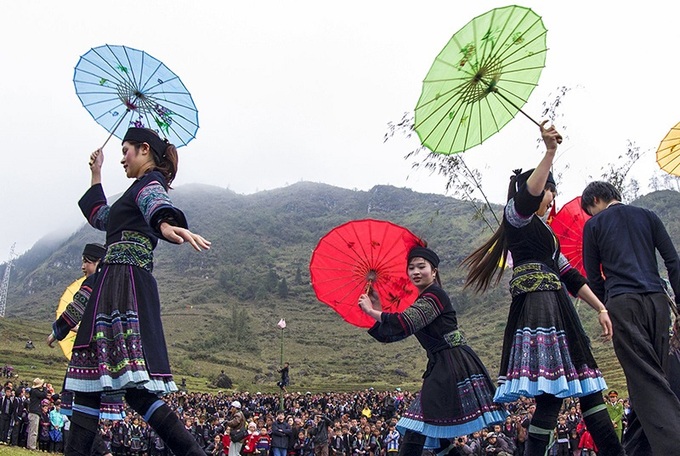The Social Practices and Beliefs of Phong Luu Khau Vai Market, or Khau Vai Love Market, in Khau Vai Commune, Meo Vac District, Ha Giang Province has become a new National Intangible Cultural Heritage of Vietnam, according to a decision of the Ministry of Culture, Sports and Tourism.

Black H'Mong girls are dancing at the Khau Vai Love Market. Photo: Vietnam Active Adventure
The history of Phong Luu Khau Vai dates back around 100 years ago. Different from others in mountainous areas, the Khau Vai Love Market, which is held once a year, is not a place for traders gathering nor agricultural exchange but for ex-lovers to meet again, talk about their current living situation and warm up their lost feeling.
“Khau Vai Love Market is considered the only one of its kind in Vietnam. Together with Dong Van Karst Plateau Geopark, the funky market is held to promote the tourism industry of the province and eliminate poverty step by step,” said the organizer of Khau Vai Love Market and Vice Chairman of Ha Giang Provincial People's Committee Tran Duc Quy
Legend has it that the Khau Vai Love Market emanated from the love story between a Hmong boy and a Giay girl that sparked a grudge between the two ethnic groups. In order to avoid bloody confrontations, they were forced to be away from each other. However, the couple vowed that they would meet once a year at Khau Vai Market.
Today, the one-in-a-year meet-up became the dating fair, for young people to find love and married couples to freshen their feelings.
The market usually takes place in three days from the 26th to the 28th on the third month of the lunar calendar. On the 26th, there is a ceremony about the coming crops with everyone praying for a good harvest. Afterward, everyone leaves to the vicinity of a pagoda for dancing, food, and drink, and playing traditional games. The second day is all about cooking rice and searching for happiness. The final act of the Market is washing the Buddha’s statue.
Many cultural activities, performances of folk art and games are also organized in the market, including the dance of drums of the Giay ethnic group; the weaving of lanh cloth of the Hmong; flute making and horse riding; performance of folk songs from the Giay ethnic group; black pig race and Giay cake pounding competition.
Visitors will also have chances to taste traditional specialties such as maize wine, mint-fragrant honey, smoked pork, goat hot pot, and wear the costumes of the ethnic minority women.
